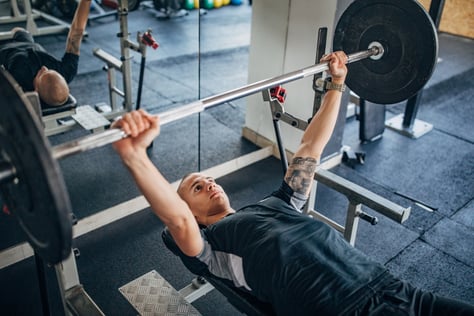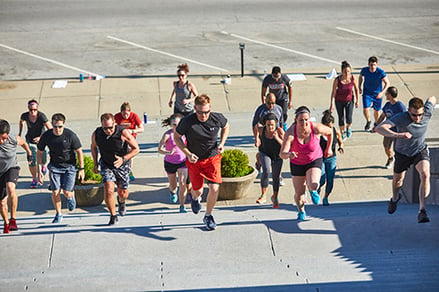 In a previous blog I discussed the importance of training within the movement categories. Those categories are upper body push and pull, squat, and hinge. To break it down even further within the categories, there are exercises that give you more bang for the buck than others. In this blog I differentiate between compound and isolation exercises. For those of you who are on a time crunch when you are in the gym, these exercises are crucial to get the most out of your training.
In a previous blog I discussed the importance of training within the movement categories. Those categories are upper body push and pull, squat, and hinge. To break it down even further within the categories, there are exercises that give you more bang for the buck than others. In this blog I differentiate between compound and isolation exercises. For those of you who are on a time crunch when you are in the gym, these exercises are crucial to get the most out of your training.
What Is the Difference?
A compound exercise is also known as a multi-joint exercise. This is an exercise in which more than one joint is required to move through the exercise. An example of a compound exercise would be a squat. To complete the squat pattern, three joints must move: the ankle, knee, and hip. Examples of compound exercises for the upper body are the bench press and overhead press. Both movements require the function of the shoulder and elbow. The reason that compound lifts have more payoff is that they work multiple muscle groups as well. A bench press uses the pectoralis muscles, deltoids, and triceps. This requires more energy to be expended than if you used only one of those muscle groups on a single joint exercise. Exercises that isolate a single muscle group are called isolation exercises. Examples of an isolation movement would be a bicep curl, triceps extension, leg extension, or a leg curl. The difference between a compound exercise and an isolation exercise is the number of joints that move.
Which Type of Exercise Should You Do?
Compound lifts are more challenging but less time consuming than performing multiple different isolation exercises. If you short on time while in the gym, a full-body workout full of compound movements will give you the most from your workout. I have written blogs about how to structure those types of workouts. If you want to sculpt your body in a particular way, and are focused on correcting muscle imbalances or injury rehabilitation, each may require the use of specific isolation movements to build up specific muscle groups. So, the question is, what are your goals? Once you define your goals, you can design your workout program.
Structuring a Workout
The most efficient way to structure a workout utilizing both methods is to perform a compound movement first in your workout followed by isolation movements to complement the muscles used in the compound movement. A quick example using the bench press would be bench pressing first, followed by isolation movements to isolate the chest and triceps. You want to save the most amount of energy for your compound exercises, which is why you should perform this one first. Fatiguing the triceps before a heavy bench workout will not yield the best results for bench press. This is why isolation exercises are best performed at the end of your workout.
For more information or guidance on how to structure your workouts, visit our training staff at the track desk in the fitness center. For nonmembers looking for help on your fitness journey, feel free to give us a call to set up a guest fitness assessment.
This blog was written by Evan James, NIFS Exercise Physiologist EP-C, Health Fitness Instructor, and Personal Trainer. To learn more about the NIFS bloggers, click here.



 The month of October, also known as ROCKTOBER or SQUATOBER and famous for Halloween, is here. I thought I would put together two workouts—a fun workout, Pumpkin Partners, and a challenging workout, The Hell Bridge—that everyone can enjoy this October! Both are great for outdoor training in cooler weather
The month of October, also known as ROCKTOBER or SQUATOBER and famous for Halloween, is here. I thought I would put together two workouts—a fun workout, Pumpkin Partners, and a challenging workout, The Hell Bridge—that everyone can enjoy this October! Both are great for outdoor training in cooler weather Picture this: It’s the last 10 minutes of your favorite group fitness class on the
Picture this: It’s the last 10 minutes of your favorite group fitness class on the  Group fitness classes are fitting for many people because the classes provide participants with predetermined workouts led by highly motivated instructors in a group setting. The niche of group fitness is constantly evolving. Classes in the category of group fitness look a lot different than they did 10 or 20 years ago. Not only do the classes look different, but they are more diverse than ever. Many participants use group fitness as supplementation for a typical workout at the gym because all you have to do is show up. Ease of participation coupled with the accountability of other members makes group fitness classes a unique environment.
Group fitness classes are fitting for many people because the classes provide participants with predetermined workouts led by highly motivated instructors in a group setting. The niche of group fitness is constantly evolving. Classes in the category of group fitness look a lot different than they did 10 or 20 years ago. Not only do the classes look different, but they are more diverse than ever. Many participants use group fitness as supplementation for a typical workout at the gym because all you have to do is show up. Ease of participation coupled with the accountability of other members makes group fitness classes a unique environment.
 The current COVID-19 pandemic is unlike anything most have experienced in their lifetimes. The dangers of this virus are still real and need to be taken seriously. Even though it seems monotonous, it is important to recognize the importance of wearing a mask and maintaining physical distancing, because at times it seems the public is becoming numb to these terms.
The current COVID-19 pandemic is unlike anything most have experienced in their lifetimes. The dangers of this virus are still real and need to be taken seriously. Even though it seems monotonous, it is important to recognize the importance of wearing a mask and maintaining physical distancing, because at times it seems the public is becoming numb to these terms.  I wish I had a dollar for every time a coach has said to me, “That athlete has stiff hips,” or “That athlete folds over at the waist,” etc. So how do I help an inefficient athlete with stiff hips? I use simple hurdle stretches that train my athletes to bend.
I wish I had a dollar for every time a coach has said to me, “That athlete has stiff hips,” or “That athlete folds over at the waist,” etc. So how do I help an inefficient athlete with stiff hips? I use simple hurdle stretches that train my athletes to bend. Let me ask you a question. Have you ever hit a plateau in the weight room when it comes to increasing strength? What about when it comes to increasing power output (vertical jump, short-distance sprint)? Well if you have, you are not alone. I know I have hit plateaus in the past and it can definitely be frustrating when you are not able to get past it.
Let me ask you a question. Have you ever hit a plateau in the weight room when it comes to increasing strength? What about when it comes to increasing power output (vertical jump, short-distance sprint)? Well if you have, you are not alone. I know I have hit plateaus in the past and it can definitely be frustrating when you are not able to get past it.